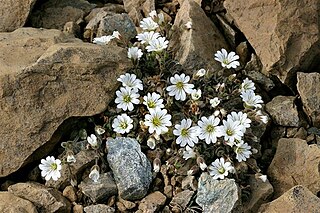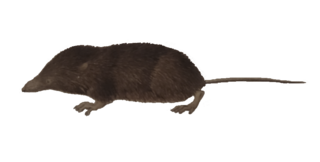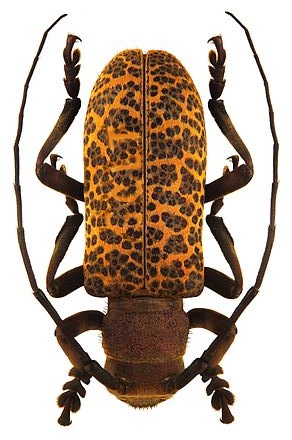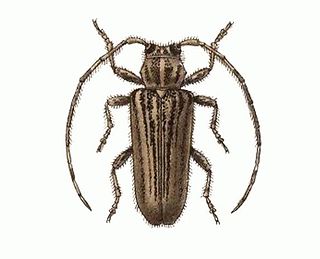
Cerastium nigrescens, commonly known as the Shetland mouse-ear, Shetland mouse-eared chickweed or Edmondston's chickweed, is an endemic flowering plant found in Shetland, Scotland.
The American Elm cultivar Ulmus americana 'Nigricans'Dieck was cloned from a selection made from seedlings raised by the Zöschener Baumschule, Zöschen, Germany, and listed by Georg Dieck with a brief description in Haupt-catalog der Obst- und gehölzbaumschulen des ritterguts Zöschen bei Merseburg, 1885.
The elm cultivar Ulmus 'Nigrescens' was identified by Pynaert as Ulmus campestris betulaefolia nigrescens. Considered by Green to be "probably Ulmus carpinifolia , but said to have been raised from seed of Purpurea".

The dark sheath-tailed bat is a species of sac-winged bat in the family Emballonuridae. It is the only species in the genus Mosia. It is found in Indonesia, Papua New Guinea, and the Solomon Islands.

The blackish antbird is a species of passerine bird in the family Thamnophilidae. It is found in Bolivia, Brazil, Colombia, Ecuador, French Guiana, Peru, and Suriname. Its natural habitats are subtropical or tropical moist lowland forests, subtropical or tropical moist montane forests, and heavily degraded former forest.

The Gorontalo macaque or Dumoga-bone macaque is a species of primate in the family Cercopithecidae. It is endemic to the island of Sulawesi in Indonesia.

The blackish small-eared shrew is a species of shrew in the family Soricidae. It is found in parts of Costa Rica, El Salvador, Guatemala, Honduras, Mexico, and Panama. An example specific habitat is the Petenes mangroves of the Yucatán.

The Himalayan shrew is a species of shrew in the subfamily Soricinae and tribe Nectogalini. It is found in Bhutan, China, India, Myanmar, and Nepal, and is the only extant species in the genus Soriculus.

The swift fruit bat is a species of megabat in the family Pteropodidae.
Thoopterus is a genus of megabat. It has two species:
A xerophile is an extremophilic organism that can grow and reproduce in conditions with a low availability of water, also known as water activity. Water activity (aw) is measured as the humidity above a substance relative to the humidity above pure water. Xerophiles are "xerotolerant", meaning tolerant of dry conditions. They can often survive in environments with water activity below 0.8; above which is typical for most life on Earth. Typically xerotolerance is used with respect to matric drying, where a substance has a low water concentration. These environments include arid desert soils. The term osmotolerance is typically applied to organisms that can grow in solutions with high solute concentrations, such as halophiles.

Senegalia nigrescens, the knobthorn, is a deciduous African tree, growing up to 18 m tall, that is found in savanna regions from West Africa to South Africa. The tree is resistant to drought, not resistant to frost and its hard wood is resistant to termites.

Estola is a genus of longhorn beetles of the subfamily Lamiinae, containing the following species:
Estola benjamini is a species of beetle in the family Cerambycidae. It was described by Stephan von Breuning in 1940. It is known from Colombia.
Estola brunnescens is a species of beetle in the family Cerambycidae. It was described by Stephan von Breuning in 1940. It is known from Colombia and Venezuela.
Estola nigropunctata is a species of beetle in the family Cerambycidae. It was described by Stephan von Breuning in 1940. It is known from Brazil.
Estola freyi is a species of beetle in the family Cerambycidae. It was described by Stephan von Breuning in 1955. It is known from Trinidad.

Estola vittulata is a species of beetle in the family Cerambycidae. It was described by Henry Walter Bates in 1874. It is known from Panama, Mexico and Venezuela.
Estola insularis is a species of beetle in the family Cerambycidae. It was described by Blair in 1933.
The elm cultivar Ulmus 'Betulaefolia Nigrescens', the Black Birch-leaved Elm, reportedly a seedling of a purplish-leaved elm, was first described by Pynaert in 1879 as U. campestris betulaefolia nigrescens. An U. campestris betulaefolia nigrescensHort. was distributed by the Späth nursery, Berlin, in the 1890s and early 1900s.









